Microsoft Surface Review
by Anand Lal Shimpi on October 23, 2012 9:01 PM EST- Posted in
- Tablets
- Microsoft
- Mobile
- Surface
- Windows RT
Display: Not Retina, But Still Good
Surface features a 10.6 inch, 1366 x 768 16:9 display. The physical size is a bit unusual, although the display resolution is something we’ve seen used in affordable notebooks for years now. We already know why Microsoft picked the display size (to enable better multitasking and make for a good keyboard size), but is there room for a flagship tablet with only a 1366 x 768 display resolution?
Microsoft’s response to the resolution question is that more pixels isn’t necessarily better, and that there are a number of other factors that are just as important. It also is quick to point out that a significantly higher resolution display would have increased memory bandwidth requirements, decreased UI frame rate and required a larger battery. As NVIDIA’s Tegra 3 only has a single channel LPDDR2 memory interface, driving a 2048 x 1536 panel and maintaining Microsoft’s UI performance requirements was out of the question. Apple ran into the same issue and ended up building the A5X SoC with an insanely wide memory interface to deal with it. Down the road I’d expect the memory bandwidth problem to get solved, but that still leaves a power consumption issue. Apple moved to a 42.5Wh battery in the 3rd generation iPad, a 37% capacity increase compared to the 31Wh unit in Surface. Enabling a similar panel would have pushed size and weight of Surface more than Microsoft would have liked.
Given those constraints Microsoft chose a different route with Surface. Rather than focus on pixel density it focused on improving contrast and reducing glare. Surface laminates the cover glass and LCD panel together, removing an annoying air gap that’s responsible for some reflections/glare and a reduction in brightness. Apple’s recently announced 8th generation iMac does something similar, as do a lot of high end smartphones, but Surface is among the first to do so with a ~10-inch LCD. The effect is noticeable in a contrived photo but it also results in a display that’s not half bad to look at.
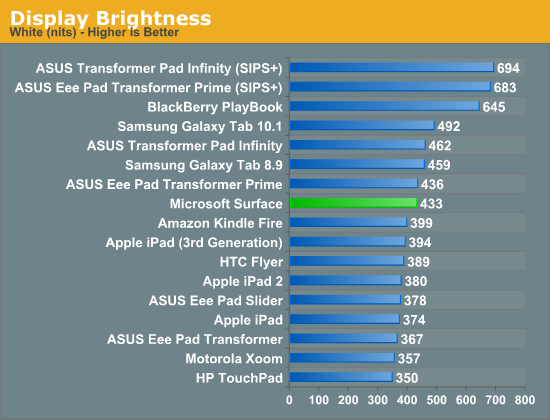
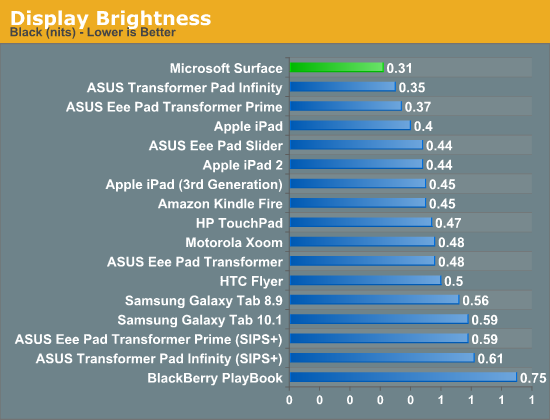
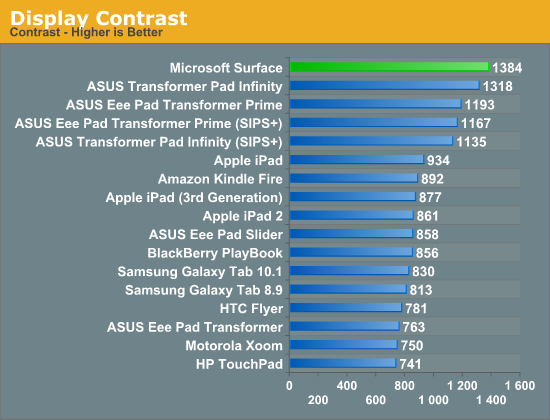
With the exception of text on web pages, the lower resolution Surface display isn’t overly bothersome. I would like something a bit higher resolution although I don’t know that matching Apple’s pixel density is absolutely necessary if Microsoft can deliver elsewhere.
Apple doesn’t just rely on resolution to sell the iPad’s Retina Display, it also happens to do quite well at accurately representing colors. I put Surface through AnandTech Senior Display Editor, Chris Heinonen’s excellent tablet/smartphone analysis workflow to see how well it did:
| CalMAN Display Comparison | ||||||
| Apple iPad (3rd gen) | Apple iPad 2 | ASUS Transformer Pad Infinity | Microsoft Surface | |||
| Grayscale 200 nits Avg dE2000 | 3.7333 | 1.3826 | 3.9881 | 3.6769 | ||
| CCT Avg (K) | 6857K | 6632K | 6632K | 6407K | ||
| Saturation Sweep Avg dE2000 | 3.193 | 6.8404 | 6.8404 | 7.3617 | ||
| GMB Colorchecker Avg dE2000 | 3.0698 | 3.8957 | 4.4177 | 5.3057 | ||
Saturation

Gamut
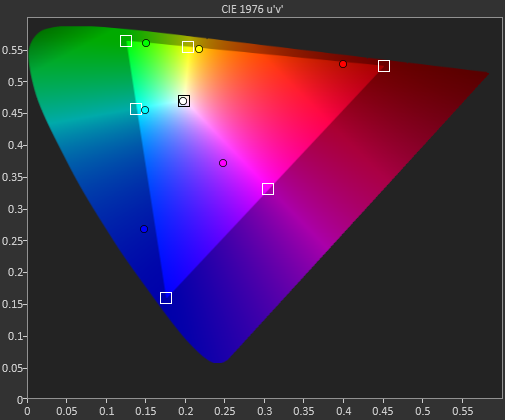
GMB Color Checker
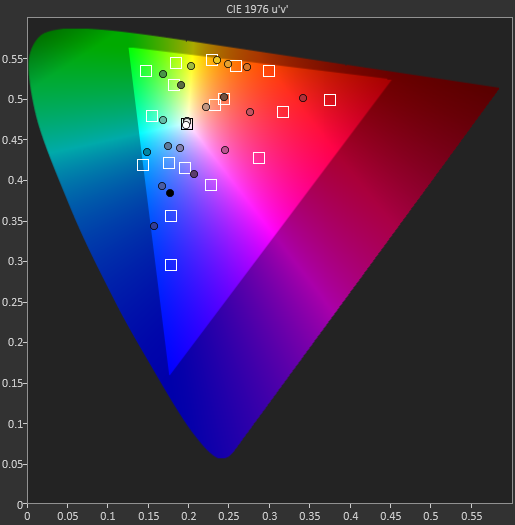
Grayscale accuracy is slightly better on Surface compared to the iPad, however the rest of the accuracy metrics show Apple’s tablet ahead of Surface.
This isn’t to say that Surface’s display is bad, in fact I think it’s quite good and I’d argue that it was never a problem in my testing, but it’s definitely not the best on the market today. I’m also not sure how much of this has to do with Microsoft’s panel selection vs. software calibration. None of my calibration tools work under Windows RT so I couldn’t really tell you.
I did reach out to Microsoft and they did say that some of my values in the charts below looked a little off. I’ll be rerunning data on another Surface sample as soon as I get a chance to.










235 Comments
View All Comments
Shadowmaster625 - Wednesday, October 24, 2012 - link
Doesnt it bother you that simply typing a vanilla document in Office uses so much cpu power. You think they are ever going to fix that? What happens when you give it access to much more cpu resources? Will it simply consume it all?andrewaggb - Wednesday, October 24, 2012 - link
Both Anand and Vivek said it keeps up though, which is the main thing I think. And these are guys who type for a living. Really it drives home that anything slower than tegra 3 wouldn't cut it and tegra 3 is barely fast enough.As for what happens when you give it more cpu, how does word run on your current desktop? On my first gen core i7 laptop (dual core), I can get word up to 4% cpu in task mgr by key bashing.
I'd be very interested in seeing what battery life and video performance an atom based tablet gets.
robmuld - Wednesday, October 24, 2012 - link
The choice of 16:9 for the display just tells me Microsoft will never get itN4g4rok - Wednesday, October 24, 2012 - link
Have you looked at the Pro version spec sheet?WP7Mango - Wednesday, October 24, 2012 - link
Actually, Microsoft DO get it. There are 3 reasons why 16:9 is preferable -1. It allows for the Windows 8 / RT multitasking feature - two apps snapped side by side, with one app taking up a thin column whilst the other app taking up a larger portion. These can be swapped round just by dragging the seperator between them. Even the desktop can be snapped with a metro app this way. It's an elegant solution to multitasking on a tablet, and a feature that the iPad doesn't have.
2. It's the ideal size for watching movies whilst minimising black borders.
3. The extra horizonal screen space gives you more flexibility in terms of app UI capabilities.
ET - Wednesday, October 24, 2012 - link
I think it's a pity that Microsoft doesn't allow running .NET apps on the desktop interface. That would have made Window RT comparable to Windows 8 and allowed using the Surface as a full PC, with a decent choice of software already available.jamawass - Wednesday, October 24, 2012 - link
Interesting review. Does the usb port support cameras? Can pictures be transferred from a camera to the surface as on a desktop?WP7Mango - Wednesday, October 24, 2012 - link
Yes, the USB port does support cameras. Yes, pictures can be transferred from a camera to the Surface just like you can on a desktop PC.karasaj - Wednesday, October 24, 2012 - link
I don't know if you're still answering questions Anand (or any staff) but do you think Surface RT would suffice for a university student who just needs to rapidly type on Microsoft office for ~50 minutes without it feeling sluggish at all? That and streaming netflix are probably all that I need to do with Surface, if I can do that, then I'd pay for surface over an ultrabook (i.e. vizio ct14-a0) for the portability and battery life.B3an - Thursday, October 25, 2012 - link
I think Surface would be the best option for that kind of stuff. It's perfectly suited for it. My brother is at uni and wants the same kind of thing, and he's getting a Surface.